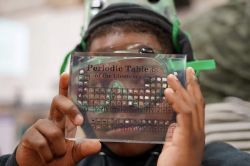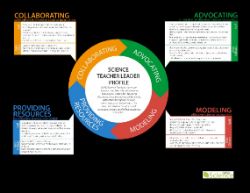A Remedy for the “Opportunity Myth”: Bringing the NGSS Progressions to Life with TK-12 Teacher Collaboration
By: Sarah Pipping and the Oakland Core Leadership Team
“So my students used bromothymol blue as an indicator to investigate cellular respiration and photosynthesis,” the 9th-grade Biology teacher proudly explained. “Oh yeah, I know that lab, I did it a few weeks ago with my students,” responded the 5th-grade teacher. “And I plan on doing that this year, too!”, the 7th-grade teacher chimed in.
Many students experience the same scientific investigations repeatedly over the course of their TK-12 education. Unfortunately, their experiences with those phenomena do not increase in complexity as they progress up the grades. As our students journey down the river of scientific knowledge throughout their education, much their scientific understanding gets trapped in a cognitive eddy. Luckily, the Next Generation Science Standards (NGSS) provide us with a framework that acts as a guide to push our students through the bends and rapids of their TK-12 scientific learning and empower them to navigate future scientific journeys.
A major conceptual shift of the NGSS is the coherent TK-12 progression of science concepts. The National Research Council postulates, “To develop a thorough understanding of scientific explanations of the world, students need sustained opportunities to work with and develop the underlying ideas and to appreciate those ideas’ interconnections over a period of years rather than weeks or months....because learning progressions extend over multiple years, they can prompt educators to consider how topics are presented at each grade level so that they build on prior understanding and can support increasingly sophisticated learning” (A Framework for TK-12 Science Education). Appendix A of the NGSS further elucidates: “the same ideas or details are not covered each year. Rather, a progression of knowledge occurs from grade band to grade band that gives students the opportunity to learn more complex material, leading to an overall understanding of science by the end of high school.” We cannot maintain the status quo of science learning and teacher professional learning and magically assume the learning progressions will come to life.
While students experiencing the same lab over and over in their science classes may be common, teachers from different grades discussing their teaching and curriculum are rare. We believe this lack of cross-grade collaboration and vertical alignment contributes to what The New Teacher Project (TNTP) refers to as “The Opportunity Myth.” The TNTP research study found, “Students only demonstrated mastery of grade-level standards on their assignments—a benchmark for being on track for the lives most of them want as adults—17 percent of the time. That gap exists because so few assignments actually gave students a chance to demonstrate grade-level mastery...students spent more than 500 hours per school year on assignments that weren’t appropriate for their grade and with instruction that didn’t ask enough of them—the equivalent of six months of wasted class time in each core subject” (TNTP, 2018). The study identifies four key resources that help students succeed: 1) grade-appropriate assignments, 2) strong instruction, 3) deep engagement, and 4) teachers who hold high expectations. In Oakland Unified, we are committed to providing these 4 key resources to students in our science classrooms because they will lead to high-quality learning, relevancy, and cultural inclusions for our students. How do we do it? By investing in our teachers.
Grade-Appropriate Assignments: In conjunction with the development of the California Science Framework, we brought teachers together to make sense of the NGSS and write high-quality, transitional learning tasks and phenomenon-driven units. For Grades K-5, this took the form of a supplemental resource called Science Instruction Reflection and Assessment, or SIRA, which supported teachers with bringing in the Science and Engineering Practices and Crosscutting Concepts into the existing curriculum. In Grades 6-12 we built out full, year-long scope and sequences and curricula. Teachers continue to refer to this curriculum development process as the most meaningful professional learning experience they have ever been a part of. In more recent years, we have adopted and purchased an NGSS-aligned curriculum for all elementary and middle schools and recommitted to a centralized system for providing materials and equipment for hands-on investigations. This year, we are launching several new initiatives with partner organizations to develop NGSS-aligned, open-source curricula for core high school courses.

observing a class. Prior to the Learning
Walk the Principal and Science Teacher
Leader sat down to review
Strong Instruction: In our district, we developed a common TK-12 framework for high-quality science program, our OUSD TK-12 Science Program Development Continuum. This framework anchors our TK-12 science program, calling out the pedagogy and systems that support NGSS learning. The Continuum serves as a roadmap for school-wide improvement, a tool to measure growth, and a way to calibrate definitions of “high-quality science instruction” across our system. School principals and Science Teacher Leaders use the Continuum each year to reflect on their site’s NGSS Implementation and set goals. Professional Development plans at the site and district level are driven by the Continuum, and growth on the Continuum serves as a way to evaluate the impact of professional learning on teacher practice and student learning. It creates opportunities for principals and teacher leaders to see their own efficacy.

Deep Engagement: In addition to supports around curriculum implementation, in Oakland, we have consistently provided teachers with spaces to go deep in their learning of content. Through our work in the CA NGSS K-8 Early Implementation Initiative with the K-12 Alliance @WestEd, we learned the importance of creating spaces for science teachers to be science learners--so they deepen their content knowledge and have first-hand experiences in three-dimensional learning. In our Oakland Summer Institutes, we’ve partnered with local scientists to create locally relevant learning experiences for our teachers, aligned to NGSS and our curriculum. To maintain focus on alignment TK-12, we have structured our summer institutes so that teachers across grade spans engage together in their content learning. We partner Elementary Teacher Leaders, Secondary Teacher Leaders, and scientists together as facilitators--working together to make sure that all teacher participants feel safe, take risks, and make the connections between their own learning and their teaching. We then ask teachers to identify phenomena that will deeply engage their students. Working in a TK-12 space, with the standards in front of us, we figure out which phenomena fit best with which grades or how students can explore the same phenomena over multiple years. We read Zaretta Hammond’s Culturally Responsive Teaching and the Brain as we prepare upcoming lessons. We “oaklandify” our curricula so that we are always increasing the relevance and culturally responsiveness of what and how we are teaching.

Teachers who hold High Expectations: While the OUSD TK-12 Science Program Development Continuum serves to define high-quality instruction, it is our Science Teacher Leaders (STLs) who carry our vision for Oakland students and bring it to life. Our Science Teacher Leader program is the longest-standing teacher leadership program in OUSD. The STL program is a well-defined and powerful avenue for leadership for our teachers and ensures we provide “the four key resources” to our students. We have Teacher Leaders from every site who convene once a month in an auditorium at the Oakland Zoo to engage in shared learning about NGSS and engage in leadership actions. For the first many years of our program, we operated separate, parallel Teacher Leadership collaboratives for elementary teachers and secondary teachers. A few years back, we merged these two programs. What resulted was a dynamic, more powerful collaboration than anyone on our central district team could have imagined--one that has propelled our work forward in recent years. When our elementary teachers collaborate with secondary teachers, they feel increased urgency about doing their part to effectively prepare students for higher-level work in middle and high school. At the same time, when our secondary teachers see the level of writing, argumentation, and analysis that our elementary teachers facilitate, they feel inspired to push themselves, their colleagues, and their students to achieve even higher. The power of this TK-12 collaboration has inspired us to create more professional spaces were teachers collaborate across grade levels. Currently, we are leading a group of upper elementary and middle school teachers that are focused on bridging the gap between elementary and middle school and keeping our students engaged.
The Opportunity Myth affirms that “At every level of the education sector, from classrooms to statehouses, from schools of education to nonprofit offices, adults make daily choices that perpetuate a cycle of inequity and mediocrity in our schools. Consciously or not, we choose to let many students do work that’s far below their grade level” (TNTP, 2018). In Oakland, we believe creating TK-12 tools and TK-12 spaces where teachers can collaborate across grade levels is a powerful move to challenge this status quo.
Here’s what our teachers have to say about it:
- “I appreciated working with teachers from across grade levels. I learned so much from them.”
- “Our observation mini-series was really enriching. Seeing other grades was useful. Just being in another classroom was refreshing and informative.”
- “I enjoyed digging into the upper-grade curriculum--I saw so many overlaps, which will inform which investigations to prioritize next year. Yay vertical alignment!!!!!”
- “I appreciated the collaboration with multiple grade levels, especially across elementary, middle, and high school. I think one of the biggest mistakes we make in the world of education is doing so little of this.”
Sarah Pipping, a member of CSTA, works as the CA NGSS K-8 Early Implementation Initiative Project Director in Oakland Unified along with an incredible team of educators who sit on the District’s Science Core Leadership Team. Sarah and the team can be reached at sarah.pipping@ousd.org
References:
National Research Council. (2012). A Framework for K-12 Science Education: Practices, Crosscutting Concepts, and Core Ideas. Committee on a Conceptual Framework for New K-12 Science Education Standards. Board on Science Education, Division of Behavioral and Social Sciences and Education. Washington, DC: The National Academies Press.work
NGSS Lead States. (2013). Next Generation Science Standards: For States, By States: Appendix A - Conceptual Shifts in the Next Generation Science Standards. Retrieved from https://www.nextgenscience.org/sites/default/files/resource/files/Appendix%20A%20-%204.11.13%20Conceptual%20Shifts%20in%20the%20Next%20Generation%20Science%20Standards.pdf
TNTP (2018). The opportunity myth: Technical appendix. New York, NY: Author. Retrieved from https://tntp.org/assets/documents/TNTP-OppMyth_TechAppx_FINAL.pdf
Hammond, Zaretta. (2015). Culturally Responsive Teaching and the Brain: Promoting Authentic Engagement and Rigor Among Culturally and Linguistically Diverse Students. Thousand Oaks, CA: Corwin.
Cheung, R., Reinhardt, T., Stone, E. & Little, J.W. (2018). Defining teacher leadership: A framework. Phi Delta Kappan, 100 (3), 38-44.







